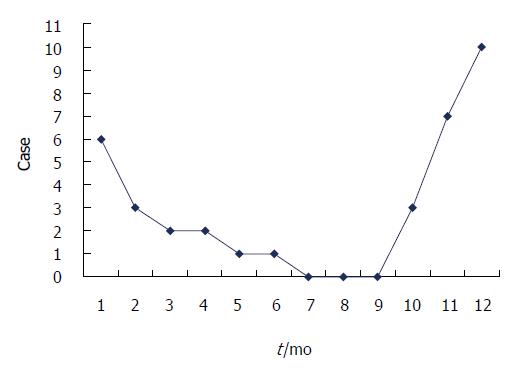Copyright
©The Author(s) 2015.
World J Gastroenterol. Sep 7, 2015; 21(33): 9774-9784
Published online Sep 7, 2015. doi: 10.3748/wjg.v21.i33.9774
Published online Sep 7, 2015. doi: 10.3748/wjg.v21.i33.9774
Figure 1 Monthly incidence of bezoar-induced small bowel obstruction.
Figure 2 Representative case of a 50-year-old female with hawthorn small bowel obstruction.
A: Computed tomography (CT) planar scan image showing that the duodenum expanded and contained an oval bezoar with gas (arrow); B: MPR image revealing the shape of bezoars and gastroduodenal anastomosis; anastomotic diameter was 4 cm (arrow); C: Peri-intestinal exudation and mesenteric vascular dilation of the distal end of SBO (arrows); D: Image displaying changes after bezoar-broken suction operation is performed.
Figure 3 Representative case of a 58-year-old male with hawthorn small bowel obstruction.
A: Contrast-enhanced examination result displaying the gastroduodenal anastomotic stoma of the artery; B: Oblique MPR revealing an oval bezoar in the distal end of the jejunum with shadows of high-density seeds (arrow); C: Sagittal reconstruction showing co-existing bezoar inside the ileum (arrow); D: Arterial phase image exhibiting the thickened and strengthened intestinal wall in the distal end of the obstruction site (arrow); E: Portal venous phase image showing a significantly enlarged vascular shadow and blurred mesentery of the proximal end of the dilated SBO intestine (arrow); F: CTA image revealing the thickening of the mesenteric blood vessel and peripheral exudation in the obstruction site (arrow).
Figure 4 Representative case of a 60-year-old female with diospyrobezoar-induced small bowel obstruction previously subjected to gastrectomy and gastrojejunostomy.
A: Computed tomography (CT) planar scan image displaying the bezoar without an envelope inside the proximal end of the ileum; B: co-existing gastric bezoar with an envelope (arrow); C: CPR image showing the dilation of the proximal end of the obstructed intestine, bezoar and distal wall thickening at the obstruction site; D: Contrast-enhanced CT scan with an arterial phase image revealing a significant enhancement and thickening of obstruction regions and the distal end of the obstructed intestine; blood-supplying arteries exhibited hyperaemia (arrow); E: CTA image showing the same mesenteric artery (arrow) that provides blood supply for the transitional zone and the distal end of the obstruction site.
Figure 5 Representative case of a 71-year-old female with diospyrobezoar-induced small bowel obstruction.
A and B: Computed tomography (CT) planar scan image revealing oval bezoars inside the gastrointestinal anastomotic stoma and the distal end of the jejunal cavity; adjacent mesentery was slightly blurred; C: The right rear end of the uterine bottom with a small amount of seroperitoneum (white arrow); D: MPR image showing the shape of a bezoar and a linear envelope (solid arrow); E: Artery phase image displaying no thickening of the distal intestinal wall at the obstruction site but with significant enhancement; F: CTA image showing different mesenteric arteries (dotted arrow) that provide blood supply for the transitional zone and the distal end of the obstruction site.
- Citation: Wang PY, Wang X, Zhang L, Li HF, Chen L, Wang X, Wang B. Bezoar-induced small bowel obstruction: Clinical characteristics and diagnostic value of multi-slice spiral computed tomography. World J Gastroenterol 2015; 21(33): 9774-9784
- URL: https://www.wjgnet.com/1007-9327/full/v21/i33/9774.htm
- DOI: https://dx.doi.org/10.3748/wjg.v21.i33.9774













